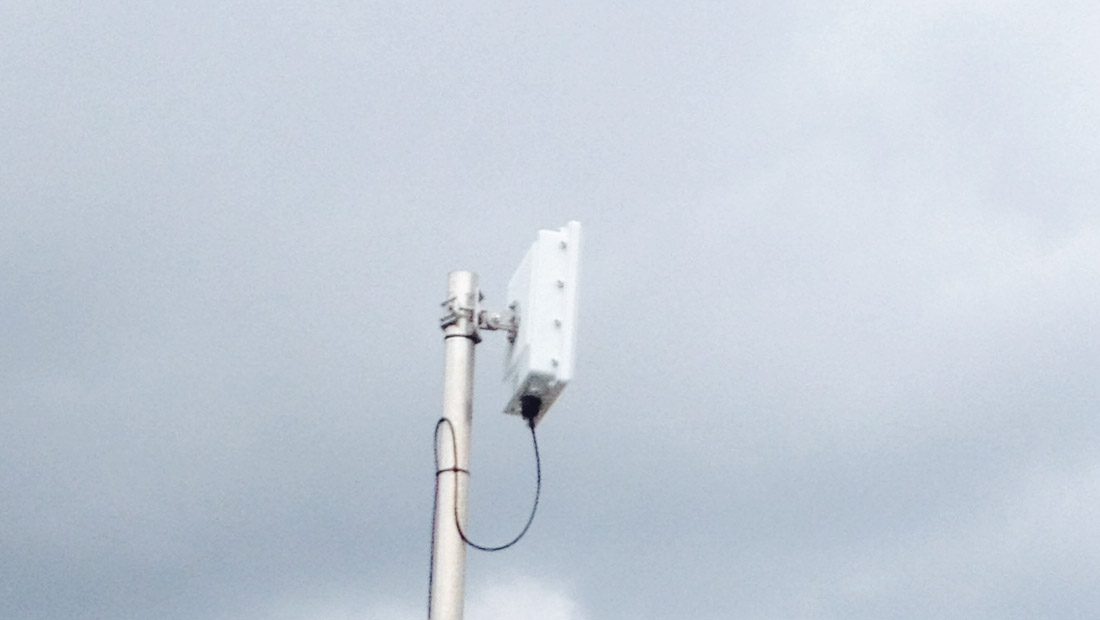
06 Feb 2014 Repeatit: Next Gen TDD Point to Point
Repeatit Trinity Point to Point
 Point to point link performance is strongly related to radio link quality and efficiency of the access protocol that decides when to use the physical medium to transfer packets over the air. While the link quality is much related to physical aspects such as distance between links, allowed output power in the frequency band and level of interference from other systems, the access protocol used on top of the physical layer plays a key role in how efficient the physical resources can be utilised.
Point to point link performance is strongly related to radio link quality and efficiency of the access protocol that decides when to use the physical medium to transfer packets over the air. While the link quality is much related to physical aspects such as distance between links, allowed output power in the frequency band and level of interference from other systems, the access protocol used on top of the physical layer plays a key role in how efficient the physical resources can be utilised.
View the Next Generation Trinity TDD here>>
Some access protocols are developed for end user access networks (like hotspots) and are not suitable to provide good performance in a point to point configuration over longer distances. Repeatit has developed a proprietary Time Division Duplex (TDD) protocol, Trinity TDD, which optimises the performance of point to point links on Repeatit’s Trinity series. This document describes the implementation of this protocol and how it differs from for example standard Wi-Fi.
Trinity TDD
Repeatit’s Trinity TDD protocol is available in the Trinity300 units and it allows for both ends of a wireless link to get access to a fair share of the radio medium while resource utilisation is optimised on the radio link layer. When Trinity TDD is used, there is no unnecessary air time wasted on acknowledgement packets or collision avoidance mechanisms. Both sides of the link know exactly when to transmit and they can send multiple IP packets with no extra radio headers inserted. Trinity TDD is not wasting resources adapting modulation for the link. As the link quality is known by both sides, the modulation rate can be optimally selected and only if problems
The basic concepts of the Trinity TDD protocol are described in the figure below:
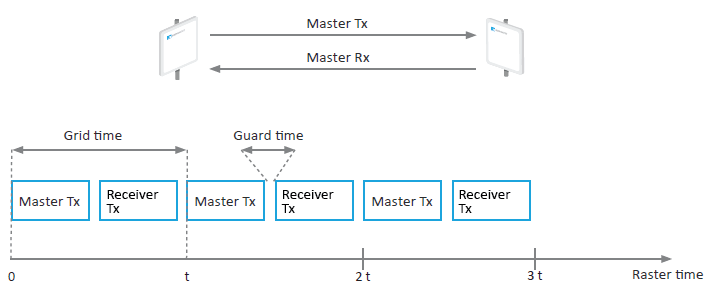
Both transmission and reception is done during the Grid Time. During the Grid Time, the following happens:
- The Master first transmits buffered packets continuously for almost half the Grid Time (noted as Master Tx in the figure).
- A short Guard Time (some micro seconds) is applied in order to cater for processing times in equipment and in some cases (if no GPS synchronisation is used) also to handle propagation delay uncertainties over the radio channel.
- The Master gets in to Rx mode and the Subscriber transmits packets for almost half the Grid Time (noted as Subscriber Tx in the figure).
- When the Subscriber is done, another Guard Time concludes the Grid before a new Grid starts.
During the Tx period from one side, the packets sent by the other end during the previous Grid are acknowledged. For example, if the Master transmits 15 packets during one Tx window, the Subscriber returns acknowledgement information about these packets in following radio frames. If a re-transmission is needed, it is handled before upper protocol layers notice.
All packet error rates and other statistics can easily be monitored in Repeatit’s Radio Control System (RCS)
The Grid Time duration is possible to edit if required. It is also possible to change the percentage of time that is used by the Master and the Subscriber for transmission during one Grid. This makes it possible to divide the capacity of the link, asymmetrical.
Interference
In order to ensure high quality on a wireless link, the operator needs to take control of the wireless medium that the link uses. For the access protocol to perform properly, the physical layer it operates on top of should not be limited by range, noise or interference. When planning out a network, known facts about the physics are commonly inserted into a link budget in order to determine which antennas and output power to use to be able to handle the range and the noise levels. The main factors to consider in such a link budget are shown in the figure below:

Figure 2 – Main factors affecting link performance. Everything marked with (+) adds positively to the link budget while (-) means that performance is reduced. Note that the receiver sensitivity level can impact both positively or negatively depending on if the link is based on carrier grade equipment (like Repeatit) or low-end equipment.
As can be seen in the figure above, output power, antenna gain and good receiver quality adds positively to the equation. Path loss, cable loss, noise and poor receiver quality degrade link performance. By using higher gain antennas, the link budget is improved and it is easier to combat interference. This is on expense of increased deployment complexity as the antenna beams may be very narrow and difficult to direct. Repeatit has long experience of deploying wireless links and always share best practice know-how with its customers. A link budget is great for determining the expected system performance, but it generally does not take external interference into account. The figure below shows an external source of interference disturbing the receiver, typically by leaking energy into the frequency band of operation. The interfering equipment is often deployed in the same mast or building as the wireless link and physical separation of the radio units and antennas could often solve most of the problems.

Figure 3 – Link budget taking external interference into account.
The most common types of external interference are described below along with some suggested ways to combat issues:
Co-channel Interference:
Many cellular (LTE, WCDMA etc.) technologies are designed for “channel re-use one”, which means that all base stations use the same frequency when transmitting. This naturally results in co-channel interference where energy from different base stations sum up in the receiver. The signals from the different base stations can often be separated by for example orthogonal codes, but the cell edge performance (where the energy is fairly equal from several transmitters) is often very poor.
The effect of co-channel interference (or “self-interference”) in for example Wi-Fi is much worse than for cellular technologies as Wi-Fi is designed for Local Area Networks where only one transmitter is expected to transmit at the time per channel. If more transmitters share the same channel, the Medium Access Protocol (MAC) forces all transmitters and all connected clients to share the same broadcast and collision domain.
Co-channel interference can be mitigated with a TDD based access protocol. A well designed TDD link does not share broadcast domain with other equipment operating on the same channel. By using a reliable synchronisation source at each site, it is also possible to combat self-interference by ensuring that all equipment mounted at each site has synchronised Tx and Rx windows. This, in combination with proper antenna isolation, effectively reduces the risk for co-channel interference to a minimum.
In-band Interference
In-band interference is typically caused by energy from other frequency bands that leaks in to the receiver of the frequency band where the own equipment operates. In the unlicensed frequency bands this is potentially a much bigger problem than in licensed frequency bands as many overlapping channels and different types of equipment are allowed. An adjacent channel may overlap in the same frequency band and corrupt the desired signal.
Another problem in the unlicensed frequency bands is that a lot of the available equipment has very bad radio design with insufficient filtering and poor linearity in power amplifiers. Some vendors are also cheating with CE/FCC verification of products.
It is not easy to fully protect your equipment from in-band interference. The best advice is to only deploy equipment from vendors that you trust. If you expect problems, schedule tests during “off peak hours” where you can turn off one transmitter at the time and see if the problem disappears. Repeatit is always sharing measurement reports and best practise know-how with Repeatit’s customers.
Out-band Interference
Out-band interference could be caused by a transmitter operating in another frequency band, producing mirror frequencies that pop up in the frequency band of operation. For example, a cellular 3G base station transmitting at 1800 MHz may cause harmonics at 3600 MHz and at 5400 MHz.
A lot of products used in unlicensed frequency bands are designed for the residential mass-market, and such equipment is seldom properly shielded and can easily generate spurious emissions from different components such as internal processors or clocks. When monitored in a spectrum plot, these emissions look like spikes and if they happen to pop up in the spectrum where the link operates they can cause permanent link degradation.
Out-band interference (often caused by equipment with high output power like a 3G base station in the same tower) is best combated by proper filtering of the own equipment, but also by carefully selecting equipment from trusted vendors that provide CE/FCC certified products. Another way of
avoiding problems is to physically separate the unlicensed equipment from equipment using licensed frequencies.
Synchronisation
Synchronisation in a PtP system is not only used for the Master/Receiver to know when to transmit. It is common that several links that are mounted in the same mast/building share the same channel (or center frequency). If these links do not have aligned Tx/Rx windows they will likely disturb each other, and therefore n synchronisation source is used as a common clock per site.
A common misunderstanding in the industry is that GPS synchronisation is required on all sites in a backhaul network in order to combat self-interference. The truth is that a common synchronisation source often makes sense in sites where channels are reused, but that the synchronisation between sites often can (and should) be solved without a common GPS solution. This is illustrated in the figure below.
Figure 4 – Example configuration to illustrate how to coordinate two different sites with individual site synchronisation.
The basic requirements that have to be fulfilled to share channels in the same sites are:
- The antenna isolation needs to be sufficiently good so that an incoming signal only can be registered by the receiver it is meant for. This will reduce the risk of in-band interference.
- The TX/RX windows for all units sharing the same channel at the same site need to be synchronised in order to avoid co-channel interference.
At both sites A and B only one channel is used, this of course demands that the antenna isolation is considered sufficient. By using different channels on the two sites it is possible to configure each site individually. On site A it might be company customers that demands a FD services but on site B there could be video surveillance cameras, which requires an asymmetrical bandwidth. With a GPS solution where all sites are synchronised and configured the same way this would not be possible.
Another example could be that one of the links at site A needs asymmetrical bandwidth, in that case it should be using a different channel than the other three links. Also in this case GPS synchronisation is not needed and would rather complicate things.
To synchronise a site or several sites with Repeatit Trinity-Series a SyncMaster unit has to be mounted at each site. This unit will provide accurate synchronisation signals to all connected units. The SyncMaster only provides the synchronisation signal and each link is individually configured with channel and symmetrical/asymmetrical bandwidth.
We have identified a couple of main cases that a network owner can have, we will describe them and go through how they should be configured with Repeatit equipment:
- Just one link (one Master, one Receiver).
- Several adjacent links at one site.
- Several sites synchronised with GPS.
- Two sites connected with a Trinity TDD link.
Case 1: Only one master and one receiver
The simplest setup is when two Trinity TDD units are connected in a point to point configuration with no other equipment operating on the same channel in the vicinity of the mounting sites.
Repeatit simply solves synchronisation by letting the Master unit using its internal clock to frequently distribute synchronisation frames over the air to the Receiver unit. The Receiver unit gets these frames and can derive the transmission time with very low jitter, especially if it knows the distance to the Master unit. The Receiver unit clock is then aligned with the Master clock. The guard time intervals described in the first part of
this document are inserted to handle propagation delay uncertainties. Worth noting is that even with a GPS receiver available on both sides of the link, a guard time is still needed to cater for internal processing time when packets are sent to the radio chipset.

Figure 5 – Synchronisation for one point to point link – GPS is not needed.
Case 2: Several adjacent links at one site
If several links are mounted in the same location and pointed in different direction, it is possible to reuse the channel and by that increase the number of possible links that can be used from that site. Of course the links needs to be pointed in such directions that the received signal from adjacent links is low enough as discussed earlier in the document. Repeatit Trinity TDD system provides a special unit called SyncMaster to perform the synchronisation of the units. Links that should be synchronised is configured to have the SyncMaster as reference. The SyncMaster then provides a reliable synchronisation signal to all connected links. The synchronisation of each links Receiver unit is then done by each link by itself.
In this case all Master units needs to be mounted on the same site where the SyncMaster is located.
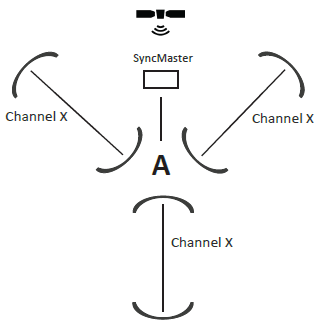
Figure 6 – Synchronisation several links at one site using SyncMaster.
Case 3: Several sites synchronised with GPS
Multiple sites that will create co-channel interference needs to be separated with SyncMaster in each site. The SyncMasters provides reliable synchronisation to all units, which means that the system can schedule transmission per unit in order to minimise co-channel interference and noise.
All sites needs to set the SyncMaster clock in the same phase, even or odd.
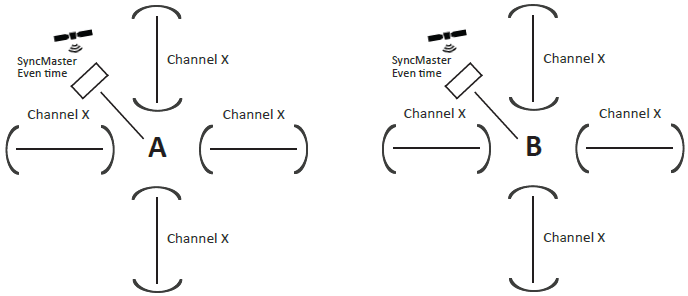
Figure 7 – Multiple sites with SyncMaster in each site.
Case 4: Two sites connected with a Trinity TDD link
When two sites are connected in a multi-hop scenario and the same channel is used, then both sites need to have a SyncMaster unit. The SyncMasters need to be set in different phases to enable the connecting link to work properly. The link would otherwise be disturbed by the other links at the same site.
Since the two sites are in opposite phase it is also important to check that no links on either sites are disturbed by the opposite site. This is crucial as they are working in different phase.
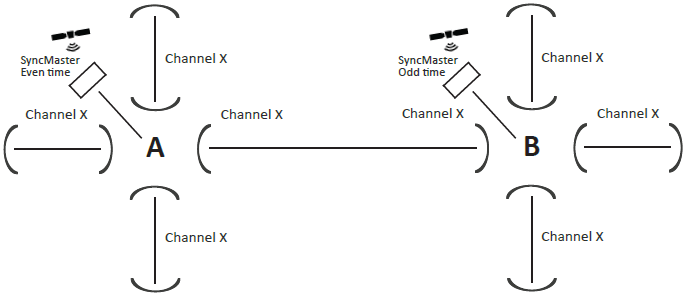
Figure 8 – Multi-hop scenario. Synchronisation in different phases for each site.
George’s Google+ Profile